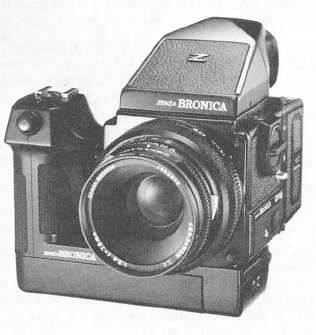FOCUS
Courtesy of Tamron Industries, Inc.
302.267x
Figure 4-6.–Bronica ETRS medium-format camera.
Both front and rear focusing
Bellows that extend to permit at least a 1:1 image
ratio
In addition to the features listed above, the view
camera has additional features that control image
sharpness and distortion. The view camera is discussed
later in this chapter.
CAMERA CONTROLS
When you take a picture, the camera causes light
reflected from the subject to be imaged on
light-sensitive material. The camera controls this action
in several ways. The first control is focus. Cameras have
components to show what part of the scene will be
recorded in sharp focus on the film. For example, some
cameras use a coincidence or split-image range finder,
and others use a focusing screen or ground glass.
The second camera control is the lens aperture.
This control is located next to the focusing ring on most
cameras. As discussed in chapter 1, the aperture affects
both focus and exposure.
The third control is shutter speed. The shutter
controls the length of time light is admitted to the film.
Shutter speed also has an effect on the way movement
is recorded on film.
Focusing involves adjusting the distance between
the lens and the focal plane, or film plane, when
photographing subjects at various camera-to-subject
distances. When a camera lens is focused on a subject
point, all light rays from that point, and only that point,
are brought to sharp focus at the film plane. When about
600 or more feet from the camera, the subject is
considered to be at infinity. A subject at infinity is so far
from the camera that rays of light reflected to the lens
from the subject are considered parallel. When a camera
is focused on a subject at infinity, the distance between
the optical center of the lens and the film plane
(lens-to-film distance) is equal to the lens focal length.
At this point the lens is closest to the film plane. As the
camera-to-subject distance decreases, the lens-to-film
distance must be increased to bring the subject into
focus.
When you are taking a picture of only one subject,
focusing is simple; however, when you want to include
several subjects at different distances from the camera
in the same picture and have them all in sharp focus, it
becomes more complicated. Unless the subject is distant
scenery with nothing in the foreground, there is always
one object that is closer to the camera than another. Then
you must decide what part of the scene is to appear in
sharp focus. In simple cases, such as a sailor standing
against a plain background, the decision is simple-focus
on the sailor. In more complex cases, when subjects both
close and far from the camera must be in sharp focus,
you should focus about one third of the distance into the
scene. In other words, focus about one third of the
distance between the closest and farthest subject you
want in sharp focus. This is known as the depth of field.
The way you focus the camera will depend on what
part of the picture is most important and its purpose; for
example, the pictures a civil engineer needs of a building
at a naval air station is altogether different from the
pictures a visitor to the air station wants to take home.
The engineer needs pictures that show a maximum
amount of detail throughout the scene. The visitor, on
the other hand, is more interested in pictures that bring
back pleasant memories. The requirements of the
picture determine what you should focus on. The
engineer needs to have everything in the picture in sharp
focus. You might accomplish this as follows: Measure
the distance to the nearest point of the picture and the
distance to the farthest part of the scene. Then consult
the depth-of-field scale on the camera lens to focus on
a point between these two distances. Now, when the lens
is stopped down to a small aperture, the depth of field is
4-5


